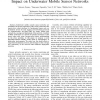Free Online Productivity Tools
i2Speak
i2Symbol
i2OCR
iTex2Img
iWeb2Print
iWeb2Shot
i2Type
iPdf2Split
iPdf2Merge
i2Bopomofo
i2Arabic
i2Style
i2Image
i2PDF
iLatex2Rtf
Sci2ools
INFOCOM
2008
IEEE
2008
IEEE
The Meandering Current Mobility Model and its Impact on Underwater Mobile Sensor Networks
—Underwater mobile acoustic sensor networks are promising tools for the exploration of the oceans. These networks require new robust solutions for fundamental issues such as: localization service for data tagging and networking protocols for communication. All these tasks are closely related with connectivity, coverage and deployment of the network. A realistic mobility model that can capture the physical movement of the sensor nodes with ocean currents gives better understanding on the above problems. In this paper, we propose a novel physically-inspired mobility model which is representative of underwater environments. We study how the model affects a range-based localization protocol, and its impact on the coverage and connectivity of the network under different deployment scenarios.
Acoustic Sensor Networks | Communications | INFOCOM 2008 | Mobility Model | Realistic Mobility Model |
| Added | 31 May 2010 |
| Updated | 31 May 2010 |
| Type | Conference |
| Year | 2008 |
| Where | INFOCOM |
| Authors | Antonio Caruso, Francesco Paparella, Luiz Filipe M. Vieira, Melike Erol, Mario Gerla |
Comments (0)

